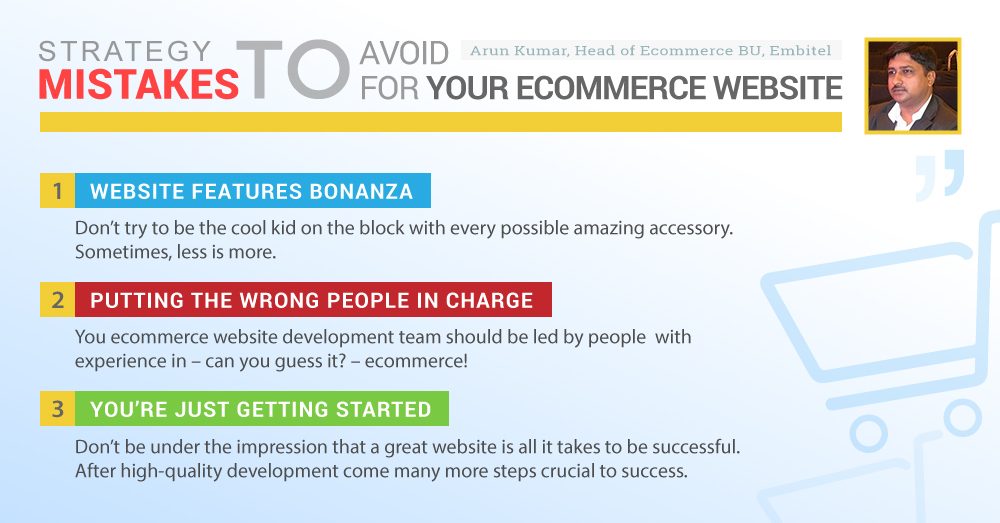
Arun Kumar is the head of the Ecommerce BU at Embitel Technologies.
I’ve consulted for many ecommerce projects in my 10-year career as the head of ecommerce at Embitel, and it’s been exciting every time.
An ecommerce website is required to support features unique to its industry, and to its business model and operational needs. For instance, service-based offerings need to have relevant payment methods like advance payments and time-slots for service fulfillment; grocery ecommerce is often supported with hyper-local offerings, click & collect, recipes, etc. In case of jewelry, businesses might request barcoding of inventory, made-to-order items, etc.
Further, even within sectors, each project presents unique challenges, and addressing these distinct requirements has helped us understand how we, as ecommerce consultants, can give ecommerce businesses what’s best for them.
In the course of providing our ecommerce consulting services, I have observed a few common hurdles that arise during ecommerce projects. It’s easy for business owners to get waylaid by these, irrespective of the industry they are catering to, or the scale they are working at.
- Choosing the right ecommerce website features
- Develop everything that is possible
- Get the best of all
- Getting more and more enhancements – to create the world’s best ecommerce website
- Increase website traffic,
- Reduce your ecommerce website bounce rate,
- Reduce cart abandonment,
- Make navigation easier,
- Or something else?
- Build a team with a deep understanding of ecommerce business and operations
- Ecommerce website development is just the beginning
An early stage in the consulting process at which clients often face roadblocks is identifying their ecommerce project requirements clearly. The broad-level requests we usually get are ‘developing a new ecommerce website’ or ‘revamping an existing ecommerce website.’ But within this is a crucial detail: what are the required features and functionalities?
Here are some common situations that arise when ecommerce managers and business owners try to assess the features and functionalities they would like to implement on their website:
Clients sometimes ask us to spell out what we can do and then implement it all. This includes everything, right from sophisticated search features (like displaying all product variations) to ‘share your purchase on social media’ button.
The thought behind this may be to dazzle the user with great features, but it is easy to go overboard and forget one’s genuine business requirements in the face of the amazing possibilities available during the consulting stage.
Get Flipkart’s great ‘search’ feature, Amazon’s ‘People who purchased this also bought…’ carousel, and Walmart’s ‘buy online, pickup offline’ button.
Each ecommerce website has its strengths, and clients often browse a variety of websites to get inspiration for what they would like to see on their own website.
Once again, this means we ending up including features that aren’t necessary to the business, or create compatibility issues on the backend due to a hash of complex features developed with multiple plug-ins and extensions.
When evaluating the many capabilities of ecommerce websites, it is difficult to know how much is enough to include, and when to consider one’s website complete. This is especially true when you’re still brainstorming and your ideas are on paper. For example, is a basic search field enough? Do you need an autocomplete widget for your search bar? Or do you need to take it even further and display all similar items in the search suggestions?
It can go on and on, and one doesn’t recognize when to stop for fear of missing out on a great feature.
While these are the common problems faced when assessing one’s requirements for an ecommerce website, what is the solution?
In order to recognize what your ecommerce website really needs, there is one important parameter: identifying your goals.
Do you want to:
Once you are clear about your KPIs, it is easier to analyze features against these and ask yourself, does this offering help me achieve my KPI? Will it help my business?
By no means a silver bullet, this method will certainly help in identifying the needs of your ecommerce website better, and taking you one step closer to great ecommerce website.
Remember, though, to review your KPIs periodically, weed out the unsuitable ones, and devise newer ways to achieve the unmet goals.
Business owners are excited to expand their presence to the online world and tap into the huge potential of the ecommerce market. They put together an internal team to lead the ecommerce initiative, and the team enthusiastically strives to deliver delight to their customers and offer every conceivable convenience.
In this endeavor business owners often lose sight of a basic but essential aspect – viability.
Caught up in development and implementation, businesses often get overwhelmed in the nitty-gritties and veer off the path of the actual goal—to sell more through online channels.
A practical way of avoiding this and ensuring achievement of targets through ecommerce is to put people who have experience in ecommerce implementation in charge, instead of simply assigning the project to those who are ready for more responsibility but lack prior experience.
This team is not just the liaison between your business management and the technology vendor, but has a direct impact on the quality of implementation.
A passion to achieve success is needed, as is the vision to recognize what is essential to success of the ecommerce website. Experience in ecommerce implementation helps the ecommerce managers to successfully pursue vital aspects of the lengthy and tedious development process, while letting go of the details that they recognize as extraneous.
Ecommerce website development is a lengthy process that calls for great attention to detail. As teams throw themselves headlong into the task, there is a sense of jubilation upon completion of the website, when it goes live. But a great ecommerce website is not the end, it is the means to the end.
Ecommerce website development is only one of the first steps in the journey to ecommerce success. It also is necessary to spread the news of the existence of the website, attract the desired number and profile of visitors to the webstore, and then actually implement the order fulfilment and delivery with speed and efficiency.
Continued efforts have to be made not just towards website maintenance, but also to ensure smooth operations.
Ecommerce is a dynamic channel of business, and it’s important to stay on your toes to adapt and respond fast enough. This is hard work, but this is also what makes ecommerce an exciting and lucrative avenue.




